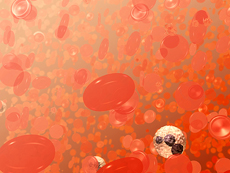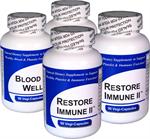Featured Health Support Products
ITP Kit
The all herbal formulas in the ITP Kit are developed by Doctors based on their understanding of how to naturally support:
- Healthy Normal Platelet Counts & Quality*
- Healthy Blood Coagulation Function*
- Promoting Normal Healing from Bruising, Petechiae or Bleeding*
Contains one month supply of:
Blood Well (180 Vegi-Capsules)
Restore Immune II (180 Vegi-Capsules)
100% Money Back Guarantee!
What are Platelet Disorders & Dysfunction?
Also called: Thrombocyte disorders

Platelets help wounds heal and prevent bleeding by forming blood clots. Your bone marrow makes platelets. Problems can result from having too few or too many platelets, or from platelets that do not work properly.
If your blood has a low number of platelets, you can be at risk for mild to serious bleeding. If your blood has too many platelets, you may have a higher risk of blood clots. With other platelet disorders, the platelets do not work as they should. For example, in von Willebrand Disease, the platelets cannot stick together or cannot attach to blood vessel walls. This can cause excessive bleeding.
Treatment of platelet disorders depends on the cause.
National Heart, Lung, and Blood Institute
Source: http://www.nlm.nih.gov/medlineplus/plateletdisorders.html
Click Here for Platelet Function Health Info*![]()
Platelet Dysfunction & Low Platelet Counts
Platelets
The average person has 150,000 to 300,000 platelets in each milliliter of blood.
Low Platelet Count & I.T.P.
Idiopathic Thrombocytopenic Purpura, also known as I.T.P., is a condition of having a low platelet count (thrombocytopenia) of no known cause.
Platelet Count
An adequate number of normally functioning platelets is needed for people with I.T.P. to prevent leakage of red blood cells from apparently uninjured vessels as well to prevent a hemorrhage. A hemophiliac's blood cannot clot since they have a hereditary or genetic disorder that impairs the body's ability to control clotting. Providing correct proteins (clotting factors) has been a common method of treating hemophiliacs.
What are Platelets?
Platelets are tiny blood cells with irregularly-shapes that are produced in the bone marrow and whose main function is to control bleeding since they take part in the blood clotting process (coagulation). Each platelet contains cytoplasmic granules and compounds that enhance their ability to stick to each other as well as adhere to tears and damage in blood vessel walls. Platelets circulate for about 10 days before being removed by the liver and spleen.
[Top]
Platelet Count Test
A platelet count is a test to measure how many platelets you have in your blood. Platelets help the blood clot. They are smaller than red or white blood cells.
[Top]
How the Test is Performed
Blood is typically drawn from a vein, usually from the inside of the elbow or the back of the hand. The site is cleaned with germ-killing medicine (antiseptic). The health care provider wraps an elastic band around the upper arm to apply pressure to the area and make the vein swell with blood.
Next, the health care provider gently inserts a needle into the vein. The blood collects into an airtight vial or tube attached to the needle. The elastic band is removed from your arm.
Once the blood has been collected, the needle is removed, and the puncture site is covered to stop any bleeding.
In infants or young children, a sharp tool called a lancet may be used to puncture the skin and make it bleed. The blood collects into a small glass tube called a pipette, or onto a slide or test strip. A bandage may be placed over the area if there is any bleeding.
[Top]
How to Prepare for the Test
No preparation is necessary. Tell your doctor if you are taking any medications, including over-the-counter medicines and supplements.
Drugs that can lower platelet counts include chemotherapy drugs, chloramphenicol, colchicine, H2 blocking agents, heparin, hydralazine, indomethacin, isoniazid, quinidine, streptomycin, sulfonamide, thiazide diuretic, and tolbutamide.
[Top]
How the Test Will Feel
When the needle is inserted to draw blood, some people feel moderate pain, while others feel only a prick or stinging sensation. Afterward, there may be some throbbing.
[Top]
Why the Test is Performed
The number of platelets in your blood can be affected by many diseases. Platelets may be counted to monitor or diagnose diseases, or identify the cause of excess bleeding.
[Top]
Normal Results
150,000 to 400,000 platelets per microliter (mcL)
Note: Normal value ranges may vary slightly among different laboratories. Talk to your doctor about the meaning of your specific test results.
[Top]
What Abnormal Results Mean
If the number of platelets is below normal (thrombocytopenia), the cause may be:
- Cancer chemotherapy
- Disseminated intravascular coagulation (DIC)
- Hemolytic anemia
- Hypersplenism
- Idiopathic thrombocytopenic purpura (I.T.P.)
- Leukemia
- Massive blood transfusion
- Prosthetic heart valve
If the number is higher than normal (thrombocytosis), the cause may be:
- Anemia
- Certain types of cancer
- Early chronic myelogenous leukemia (CML)
- Polycythemia vera
- Primary thrombocytosis
- Recent spleen removal
[Top]
Risks
There is very little risk involved with having your blood taken. Veins and arteries vary in size from one patient to another and from one side of the body to the other. Taking blood from some people may be more difficult than from others.
Other risks associated with having blood drawn are slight but may include:
- Excessive bleeding
- Fainting or feeling light-headed
- Hematoma (blood accumulating under the skin)
- Infection (a slight risk any time the skin is broken)
[Top]
Alternative Names
Thrombocyte count
[Top]
Read More
- Thrombocytopenia
- Chemotherapy
- Disseminated intravascular coagulation (DIC)
- Hemolytic anemia
- Idiopathic thrombocytopenic purpura (I.T.P.)
- Polycythemia vera
- Chronic myelogenous leukemia (CML)
[Top]
References
McMillan R. Hemorrhagic disorders: Abnormalities of platelet and vascular function. In: Goldman L, Ausiello D, eds. Cecil Medicine. 23rd ed. Philadelphia, Pa: Saunders Elsevier; 2007:chap 179.
[Top]
Source: http://www.nlm.nih.gov/medlineplus/ency/article/003647.htm
Update Date: 2/21/2009
Updated by: David C. Dugdale, III, MD, Professor of Medicine, Division of General Medicine, Department of Medicine, University of Washington School of Medicine. Also reviewed by David Zieve, MD, MHA, Medical Director, A.D.A.M., Inc.
[Top]
Platelet Aggregation Test
The platelet aggregation test checks to see how well platelets, a part of blood, clump together and cause blood clotting.
How the Test is Performed
Blood is typically drawn from a vein, usually from the inside of the elbow or the back of the hand. The site is cleaned with germ-killing medicine (antiseptic). The health care provider wraps an elastic band around the upper arm to apply pressure to the area and make the vein swell with blood.
Next, the health care provider gently inserts a needle into the vein. The blood collects into an airtight vial or tube attached to the needle. The elastic band is removed from your arm.
Once the blood has been collected, the needle is removed, and the puncture site is covered to stop any bleeding.
In infants or young children, a sharp tool called a lancet may be used to puncture the skin and make it bleed. The blood collects into a small glass tube called a pipette, or onto a slide or test strip. A bandage may be placed over the area if there is any bleeding.
The laboratory specialist will look at how the platelets spread out in the liquid part of the blood (plasma) and whether they form clumps after a certain chemical or drug is added. When platelets clump together, the blood sample is more clear. A machine measures the changes in cloudiness and prints a record of the results.
[Top]
How to Prepare for the Test
Many medications may affect test results. Tell your health care provider about any medications (including over-the-counter drugs) you have taken within 2 weeks before the test.
Medications that may alter test results include:
- Aspirin
- Aspirin compounds
- Nonsteroidal anti-inflammatory drugs (NSAIDs) such as ibuprofen
- Tricyclic antidepressants
- Antihistamines
- Some antibiotics
[Top]
How the Test Will Feel
When the needle is inserted to draw blood, some people feel moderate pain. Others feel only a prick or stinging sensation. Afterward, there may be some throbbing.
[Top]
Why the Test is Performed
Your doctor may order this test if you have signs of a bleeding disorder or low-platelet count, or if a member of your family has a known bleeding disorder due to platelet dysfunction.
The test can help diagnose problems with platelet function and determine whether the problem is due to your genes, another disorders, or even a side effect of medicine.
See also: Platelet count
[Top]
Normal Results
The normal time it takes platelets to clump depends on temperature and may vary from laboratory to laboratory.
[Top]
What Abnormal Results Mean
Decreased platelet aggregation may be due to:
- Autoimmune disorders that produce antibodies against platelets
- Bernard-Soulier syndrome
- Certain medicines that block platelet formation
- Glanzmann's thrombasthenia
- Myeloproliferative disorders
- Fibrin degradation products
- Storage pool disease
- Uremia (a result of kidney failure)
- Von Willebrand's disease
[Top]
Risks
There is very little risk involved with having your blood taken. Veins and arteries vary in size from one patient to another and from one side of the body to the other. Taking blood from some people may be more difficult than from others.
Other risks associated with having blood drawn are slight but may include:
- Excessive bleeding
- Fainting or feeling light-headed
- Hematoma (blood accumulating under the skin)
- Infection (a slight risk any time the skin is broken)
Note: This test is often performed because the patient has a bleeding problem. Bleeding may be more of a risk for this person than for people without bleeding problems.
[Top]
References
McMillan R. Hemorrhagic disorders: Abnormalities of platelet and vascular function. In: Goldman L, Ausiello D, eds. Cecil Medicine. 23rd ed. Philadelphia, Pa: Saunders Elsevier; 2007:chap 179.
Schafer A. Hemorrhagic disorders: Approach to the patient with bleeding and thrombosis. In: Goldman L, Ausiello D, eds. Cecil Medicine. 23rd ed. Philadelphia, Pa: Saunders Elsevier; 2007:chap 178.
Source: http://www.nlm.nih.gov/medlineplus/ency/article/003669.htm
[Top]
Update Date: 3/2/2009
Updated by: David C. Dugdale, III, MD, Professor of Medicine, Division of General Medicine, Department of Medicine, University of Washington School of Medicine; and Yi-Bin Chen, MD, Leukemia/Bone Marrow Transplant Program, Massachusetts General Hospital. Also reviewed by David Zieve, MD, MHA, Medical Director, A.D.A.M., Inc.
Read More
- Platelet count
- Hemophilia
- Congenital platelet function defects
- Von Willebrand disease
- Autoimmune disorders
- Polycythemia vera
- Prerenal azotemia
- Acute kidney failure
- Allergic vasculitis
- Fibrin degradation products
[Top]
Click Here for Platelet Function Health Info*![]()
[Top]

 Get Well Natural, LLC
Get Well Natural, LLC  Kidney Function & Regeneration Health
Kidney Function & Regeneration Health  Platelet & Blood Cell Health
Platelet & Blood Cell Health  Prostate, Flow & Function Health
Prostate, Flow & Function Health  General Mind & Body Health
General Mind & Body Health  Heart, Cholesterol & Cardio Health
Heart, Cholesterol & Cardio Health  Allergy-Free Body
Allergy-Free Body  Anxiety & Stress
Anxiety & Stress  Blood Platelet Counts & Function
Blood Platelet Counts & Function  Blood Pressure Health
Blood Pressure Health  Kidney Function Health
Kidney Function Health  Immune System Health & Balance
Immune System Health & Balance  Prostate & Urinary Health Function
Prostate & Urinary Health Function  Blood Sugar Balance
Blood Sugar Balance  Cardiovascular Heart Health
Cardiovascular Heart Health  Detoxification & Healthy Cells
Detoxification & Healthy Cells  Women's Health
Women's Health  Liver Regeneration
Liver Regeneration  Pain-Free Body
Pain-Free Body  Water & Air Filtration
Water & Air Filtration 



